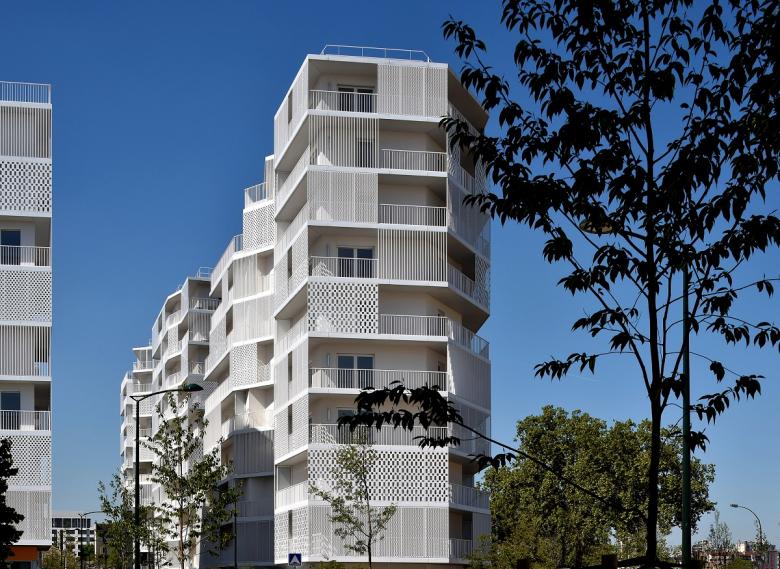Hamonic+Masson & Associés
Rue Camille Claudel
In the history of architecture it is rare to find examples of roads built entirely by the same architect. During the buzz of Ré-inventer Paris, Inventons la Métropole and other international architecture competitions, the Camille Claudel project primarily poses the question of scale.
Project: Rue Camille Claudel, 2017
Location: ZAC du Bac d’Asnières, Clichy-la-Garenne, France
Program: 170 private ownership apartments + 160 social housing apartments + nursery school + crèche + parking
Developer: SOGEPROM
Urban Planner: Obras
Architect: Hamonic+Masson & Associés
Project Manager: Marie-Agnès de Bailliencourt
MEP Engineer: ARCOBA
Landscape Architect: CoBe
Surface Area: 24,000m2
Environmental Certification: RT 2012
The trauma of the Grands Ensembles has prevented a unitary approach in architecture today. We often see urban projects divided into ‘slices’ of 50 to 60 houses under the guise of “architectural diversity.” This approach is often detrimental as it lacks consideration for town and city planning. Hamonic+Masson & Associés won the Camille Claudel project in 2013 having proposed a global and unitary strategy, which incorporated architectural diversity with evident character. Here diversity is a question of form and typology, and not simply style.
The project is organized around seven buildings on two separate plots linked by a public road. The site has its constraints, including the local flood prevention plan, building area restrictions, required transparencies and the local urban plan. However it also has its advantages such as unobstructed views of the Seine, the nearby park, the surrounding new and developing neighbourhood, and the site’s proximity to the riverbank. Each building has its own character but remains linked to its neighboring structures. The morphology of the buildings develops in a way that provides each apartment with multiple views of the Seine and maximum sunlight exposure. The buildings interact with one another in a way that creates collective spaces overlooking the new road.
The buildings are raised off the ground in order to allow the eye to wander between the structures and let the natural light penetrate the site. These open ground floors are connected to each other via the road. The physical and visual network of entrances becomes a unifying social link. The sequence of housing entrances is designed as interior prolongations of the road’s exterior space. The hallways become transparent spaces with dual aspect views. The voids between buildings and the road are landscaped in order to create a large, planted, communal garden. Plants are chosen depending on location and exposure. The extension of public space is at the heart of the system, and is a concept that will create a strong link between shared spaces, the road and the project.
One of the big questions in collective housing is that of repetition. How can we avoid this feeling in a program of 330 apartments? (60% are privately owned, and 40% are social housing.) The apartments are stratified but must offer quality and uniqueness. We have responded to the search for identity within the collective and provided differentiation by proposing multiple, varied exterior spaces. Furthermore, we have designed numerous typologies with the majority of apartments benefiting from a southwesterly orientation and views of the Seine. The buildings directly facing the river have been designed to give a strong signal of metropolitan scale.
Each building develops a linear balcony running along the length of the apartment providing each home with a vast exterior space. These spaces are finished differently depending on their location:
- Conservatories facing the Seine, providing a view but protection from the noise of the busy road,
- Full-height metal work preventing overlooking from the road or public spaces,
- Balustrade railings.
The buildings are sculpted in a way that favors maximum sunlight exposure and provides views overlooking this incredible site. They are clad in metallic lace with varied motifs, which give an identity to this new neighborhood. This detail on the façades was the opportunity to give the project an identity. In the Metropolitan skyline the lace-like panels vary according to the time of day, the weather and the seasons. The different elements will resonate, as certain locations will absorb light while others reflect it. This is an essential element of the project. Architecture is condemned to be static but different staging and cinematic measures can render the buildings dynamic, lively, provocative and can also evoke multiple sensations.
Subtly playing with framework and motifs within the unity of light and luminous tints, the project gives a refined image. However it is simply the assembling of simple materials which, when superposed and enhanced with graphics and precision, engender a poetic quality. The façades glisten and play with light and orientation. This new neighborhood shines day and night, providing the city with a new, lively and dynamic landmark.











